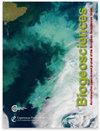临时分层促进了浅富营养化湖泊的大量温室气体排放
IF 3.9
2区 地球科学
Q1 ECOLOGY
引用次数: 1
摘要
摘要浅水湖泊和池塘经常会出现暂时的热分层现象。这对温室气体(GHG)排放有何影响尚无定论。在此,我们将 5 月至 9 月生长季节的每周温室气体排放量估算值与 11 公顷温带浅湖的温度和氧气曲线相结合,研究热分层如何影响温室气体排放量。有三个主要的分层期,底层水与大气隔离后会出现严重缺氧。在分层阶段,甲烷(CH4)和氧化亚氮(N2O)的平均扩散排放量更大且变化更多,而二氧化碳(CO2)的平均排放量较低,但这些差异在统计学上并不显著。相比之下,在分层阶段,甲烷(CH4)的逸出量明显增加。此外,在分层期结束时,随着湖水混合,CH4 和 CO2 大量外流。据估计,在 5 月至 9 月期间,两个相对孤立的翻转事件释放了大部分排放的 CH4。这些结果表明了分层模式是如何影响温室气体排放的,并强调了周转排放的作用以及高频率测量温室气体排放的必要性。本文章由计算机程序翻译,如有差异,请以英文原文为准。
Temporary stratification promotes large greenhouse gas emissions in a shallow eutrophic lake
Abstract. Shallow lakes and ponds undergo frequent temporary thermal stratification. How this affects greenhouse gas (GHG) emissions is moot, with both increased and reduced GHG emissions hypothesised. Here, weekly estimations of GHG emissions, over the growing season from May to September, were combined with temperature and oxygen profiles of an 11 ha temperate shallow lake to investigate how thermal stratification shapes GHG emissions. There were three main stratification periods with profound anoxia occurring in the bottom waters upon isolation from the atmosphere. Average diffusive emissions of methane (CH4) and nitrous oxide (N2O) were larger and more variable in the stratified phase, whereas carbon dioxide (CO2) was on average lower, though these differences were not statistically significant. In contrast, there was a significant order of magnitude increase in CH4 ebullition in the stratified phase. Furthermore, at the end of the period of stratification, there was a large efflux of CH4 and CO2 as the lake mixed. Two relatively isolated turnover events were estimated to have released the majority of the CH4 emitted between May and September. These results demonstrate how stratification patterns can shape GHG emissions and highlight the role of turnover emissions and the need for high-frequency measurements of GHG emissions, which are required to accurately characterise emissions, particularly from temporarily stratifying lakes.
求助全文
通过发布文献求助,成功后即可免费获取论文全文。
去求助
来源期刊

Biogeosciences
环境科学-地球科学综合
CiteScore
8.60
自引率
8.20%
发文量
258
审稿时长
4.2 months
期刊介绍:
Biogeosciences (BG) is an international scientific journal dedicated to the publication and discussion of research articles, short communications and review papers on all aspects of the interactions between the biological, chemical and physical processes in terrestrial or extraterrestrial life with the geosphere, hydrosphere and atmosphere. The objective of the journal is to cut across the boundaries of established sciences and achieve an interdisciplinary view of these interactions. Experimental, conceptual and modelling approaches are welcome.
 求助内容:
求助内容: 应助结果提醒方式:
应助结果提醒方式:


